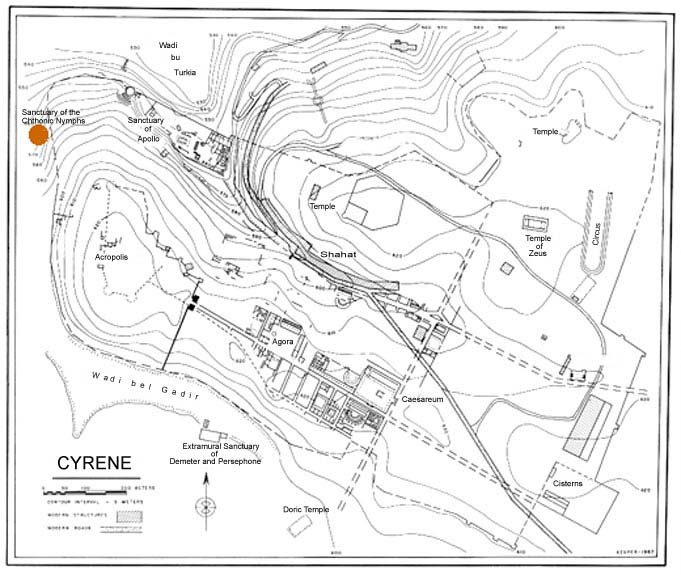
Sanctuary of the
Chthonic Nymphs
at Cyrene
Cyrenaica
Terracottas
is an interactive web site designed for
archaeologists, art historians, historians, and classicists
who have an interest in the typological diffusion of Greek
terracottas at ancient sites in Cyrenaica, Libya, as well
as elsewhere around the Greek world.
Updated August 30, 2018 |
|
The
Sanctuary of the Chthonic Nymphs at Cyrene The Terracottas
The
Sanctuary of the Chthonic Nymphs was discovered in 1911 during
excavations conducted at Cyrene by Richard Norton and a team of
8 men under the auspices of the Archaeological Institute of America
and the Museum of Fine Arts in Boston. In November of 1910 a Libyan
had informed Norton of a large find of terracotta figurines that
had been discovered in an onion garden on the north-east slope
of the acropolis and, after lengthy negotiations, Norton succeeded
in purchasing what was referred to as the "terracotta garden."
Over the course of the month of April, more than 4,500 terracottas
were brought to light. Unfortunately, during the vicissitudes
of the Second World War in North Africa, most of these terracottas
subsequently were lost. However, 20 figurines were brought to
Swansea by Dr. Sladden, the expedition doctor, and 89 were sent
to the Archaeological Institute of America from where they were
transfered to the Museum of Fine Arts in Boston. Moreover, in
the late 1920s a photographic catalogue had been made of over
1000 of these figurines that has provided precious documentation
for the typological range that was in use at the Sanctuary of
the Chthonic Nymphs. This photographic catalogue, together with
the figurines in Swansea, Boston, and at Cyrene itself, became
the focus of the publication Il Santuario delle Nymphai Chthoniai a Cirene: Il sito e le terrecotte, Rome
2000 (M. E. Michele/A. Santucci, eds.).
The Sanctuary of the Chthonic Nymphs
was located at the north-east margins of the city on the upper
slope of the acropolis but outside of the Hellenistic defensive
walls. A rustic sanctuary rather than a monumental one, it was
marked by a series of small, natural caves interspersed by irregular
niches cut into the exposed rocky outcropping of the acropolis.
Evidence suggests that small altars had been set up near these
niches. Most of the figurines date from the late 5th to the later
4th centuries B. C., even though several from the Hellenistic
period also were found. It is important to keep in mind that the
site was only partially excavated and that much still remains
to be explored.
The greater majority of the Norton
figurines represent female figures carrying silphium, a small
cup believed to have held silphium, or a gazelle; some have a
gazelle at their sides. Youthful beardless and older bearded male
types also are numerous. Stylistically these terracottas present
a rustic, unsophisticated sensibility, especially when compared
to the terracottas from the Extramural Sanctuary of Demeter and
Persephone at Cyrene. It is believed that they were expressions
of a popular piety by an indigenous population and that the Sanctuary
of the Chthonic Nymphs provided a sacred transition between the
city and the countryside where the fertility of the countryside
was protected by indigenous deities.

Plan of Cyrene with the Sanctuary of the Chthonic Nymphs indicated in red
|

|